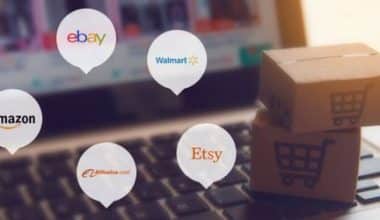According to a recent survey, 56% of businesses expect the majority of their revenue to come from e-commerce within the next three years. This opens up a wide range of opportunities for business owners to move their operations online and sell products via e-commerce. The answer to the question “What is e-commerce?” is complex. E-commerce is more than just selling things online. It includes a wide range of business types and may involve selling on more than one platform. Savvy business owners recognize the value of putting their products in front of customers online. E-commerce is changing the way businesses sell their products, process orders, and provide customer service. Let’s look at the advantages and disadvantages, types and different examples of E-commerce.
What is E-Commerce?
E-commerce refers to businesses and individuals that buy and sell goods and services over the Internet. E-commerce can be carried out on computers, tablets, smartphones, and other smart devices and works in several types of market segments. Also, e-commerce lets you buy and sell almost any product or service online, including books, music, airline tickets, and financial services like buying stocks and banking. As such, it is seen as a highly disruptive technology.
How Does E-Commerce Work
The internet is the driving force behind e-commerce. Customers use their own devices to look around an online business and order goods or services.
As the order is being placed, the customer’s web browser will talk back and forth with the server that runs the e-commerce site. The information about the order will be sent to a central computer called the order manager. It will then be sent to databases that keep track of inventory levels, a merchant system that handles payment information from apps like PayPal, and a bank computer. It will then revert to the order manager. This is done to ensure that the store’s inventory and customer funds are sufficient to process the order.
The order manager will notify the store’s web server once the order has been validated. It will show a message to the customer telling them that their order has been completed. The order manager will then send order data to the warehouse or fulfillment department, informing it that the product or service is ready to be shipped to the customer. At this moment, a customer may receive actual or digital products or access to a service may be granted.
Platforms that host e-commerce transactions include online marketplaces that sellers sign up for, such as Amazon; software as a service (SaaS) tools that allow customers to “rent” online store infrastructures; and open source tools that businesses manage with the help of in-house developers.
The Evolution of E-Commerce
Most of us have shopped for something online at some point, which means we’ve participated in e-commerce. As a result, e-commerce is widespread. However, few people are aware that e-commerce has a long history that predates the internet.
E-commerce dates back to the 1960s when businesses employed an electronic system called Electronic Data Interchange to simplify document transfer. The first transaction did not take place until 1994. This featured the sale of a CD between friends via an online shopping service called NetMarket.
Since then, the industry has undergone numerous changes, resulting in substantial evolution. As Alibaba, Amazon, eBay, and Etsy became household names, traditional brick-and-mortar stores were forced to use new technology to stay in business. These businesses set up an online marketplace where customers can easily buy and sell goods and services.
People are finding it easier to shop online as technology advances. People can communicate with businesses via smartphones and other devices, as well as download apps to make purchases. The growth of the e-commerce industry has also been helped by the fact that customers no longer have to pay for shipping.
Types of E-Commerce with Examples
Depending on the goods, services, and organization of an e-commerce company, the company might operate in a variety of ways. Here are a few examples of well-liked business models.
#1. Business to Consumer (B2C)
B2C e-commerce companies sell directly to the end user of the product. Instead of sending goods to a middleman, a B2C company does business directly with the person who will use the goods. This business model can be used to sell products or services. This is the most frequent business model and is probably what most people think of when they hear the term “e-commerce.”
#2. Business to Business (B2B)
Similar to B2C, an e-commerce business can sell goods directly to a user. However, instead of becoming a consumer, the user could be a competitor. B2B transactions can involve larger quantities, more stringent standards, and longer lead times. If the purchase is for recurring manufacturing operations, the company placing the order may also need to set up recurring goods.
#3. Business to Government (B2G)
Some businesses specialize in supplying goods or services to government agencies or administrations. Similar to a B2B partnership, the company creates valuable items and sends them to another entity. B2G e-commerce companies are frequently required to respond to government calls for proposals, solicit bids for projects, and meet very precise product or service standards. Also, the government may work together to look for a single contract through a government-wide procurement contract.
#4. Consumer to Consumer (C2C)
Only established businesses are permitted to offer goods. E-commerce platforms, such as digital marketplaces, connect consumers with other consumers who can list and sell their products. Some of these C2C platforms, like eBay auctions, are like auctions, while others, like Craigslist postings, are more like discussions about the goods or services being sold. Technology-enabled C2C e-commerce platforms allow people to buy and sell without the need for companies.
#5. Consumer to Business (C2B)
Modern platforms have made it easier for people to connect with businesses and offer their services, especially for short-term contracts, gigs, or freelance work. For example, consider the Upwork listings. A consumer may solicit bids or contact businesses that require certain services. The e-commerce platform connects businesses with freelancers in this way to provide consumers with greater control over pricing, scheduling, and employment demands.
#6. Consumer to Government (C2G)
Consumers can communicate with administrations, agencies, or governments through C2G partnerships, which are less like standard e-commerce partnerships. These partnerships are often a trade of obligations rather than an exchange of services. For example, uploading your federal tax return to the IRS digital website is an e-commerce transaction, including the exchange of information. You can also pay your university’s tuition online or send property tax assessments to your county assessor.
Advantages and Disadvantages of E-Commerce
E-commerce has many advantages, such as being open 24 hours a day, being easy to use, having a wide range of goods and services, being quick to access, and being able to reach people all over the world.
Advantages
#1. Availability.
Aside from downtime and regular maintenance, e-commerce sites are accessible 24/7, allowing visitors to browse and shop at any time. Brick-and-mortar businesses are usually open for a specific number of hours and may even close completely on certain days.
#2. Accessibility promptly.
While crowds might slow down shoppers in a physical store, e-commerce sites run swiftly, which is governed by compute and bandwidth factors on both the consumer device and the e-commerce site. Product and shopping cart pages load in a matter of seconds. An e-commerce transaction can be completed in a few clicks and within five minutes.
#3. Wide availability.
“Earth’s Biggest Bookstore” was Amazon’s first slogan. This was possible since it was an e-commerce site rather than a physical store that had to stock each book on its shelves. E-commerce lets companies sell a wide variety of goods, which are then sent out from a warehouse or multiple warehouses after a purchase is made. Customers are more likely to find what they are looking for.
#4. Simple accessibility.
Customers in a physical store may have difficulty locating a specific product. Visitors to the website can browse product category pages in real time and use the site’s search feature to find the product right away.
#5. International visibility.
Customers that visit physical stores buy from brick-and-mortar businesses. Businesses that use e-commerce can sell to anyone who has access to the web. electronic commerce has the potential to increase a company’s customer base.
#6. Reduced cost.
Pure e-commerce businesses don’t have to pay for things like rent, inventory, and cashiers, which are costs that stores have to pay for. However, they may incur shipping and warehouse expenses.
#7. Product recommendations and personalization.
E-commerce sites can keep track of a visitor’s browsing, search, and purchase history. They can use this data to create personalized product recommendations and learn more about target markets.
Disadvantages
People say that the cons of e-commerce include bad customer service, not being able to see or touch a product before buying it, and the length of time it takes for a product to ship.
#1. Limited customer service.
If a consumer has a question or an issue in a physical business, they can seek assistance from a clerk, cashier, or store manager. Customer support at an e-commerce store may be limited: The site may only offer support during certain hours, and its online services may be hard to use or not answer a specific question.
#2. Limited product experience.
Viewing pictures on a webpage can give you a good feel of a product, but it’s not the same as really experiencing it, such as playing the guitar, evaluating the picture quality of a television, or trying on a shirt or outfit. Customers who shop online may buy products that don’t meet their expectations and have to be sent back. In some situations, the customer must pay for the cost of returning an item to the retailer.
#3. Time to wait.
Customers pay for goods in a store and take them home with them. Customers who use e-commerce must wait for the merchandise to be shipped to them. Although shipping windows are decreasing as next-day and even same-day delivery become more popular, it is not quick.
#4. Security.
Skilled hackers can develop websites that appear to sell well-known products. Instead, the website delivers clients counterfeit or copycat versions of such products – or simply steals their credit card information. Legitimate e-commerce sites pose risks as well, particularly when users store their credit card information with the company to facilitate future transactions. Threat actors may steal credit card information if the retailer’s website is compromised.
How Do You Start an E-commerce Business?
Before you start your business, make sure to conduct your research. Determine what products and services you will sell and research the market, target audience, competitors, and estimated expenses.
Next, choose a name, a business structure, and documents (taxpayer numbers, licenses, and permits if they apply).
Select a platform and create your website before you start selling (or have someone do it for you). Remember to keep things simple in the beginning and to market your business through as many channels as possible.
What is the Difference Between E-Commerce and E-Business?
E-commerce is the online purchase and sale of products and services, and it is only one component of e-business. E-business refers to the full process of running a business online. Simply put, it refers to every activity associated with an online business.
What are the 3 types of e-commerce?
E-commerce is classified into three types: business-to-business (websites like Shopify), business-to-consumer (websites like Amazon), and consumer-to-consumer (websites such as eBay).
What are the benefits of e-commerce?
Understanding E-Advantages Commerce’s
- A faster purchasing process.
- Create store and product listings.
- Cost-cutting measures.
- Low-cost advertising and marketing.
- Customer adaptability.
What are the 7 features of e-commerce?
Here are the seven distinct characteristics of electronic commerce:
- Ubiquitousness.
- Global reach.
- International standards.
- Information abundance.
- Interactivity
- information density.
- Individualization.
Which is the best e-commerce platform?
Best electronic commerce platforms (Feb. 2023):
- GoDaddy. Starting pricing. $6.99 monthly
- SquareSpace. Initial Cost. $23 monthly
What are the main activities of e-commerce?
E-commerce activities include the following:
- Online buying and selling of products.
- Buying tickets online.
- Online Payment.
- Paying various taxes.
- Online accounting software.
- Online customer service.
Is Amazon e-commerce?
Yes. If you’re seeking a way to showcase products and reach new clients, an Amazon Store could be a fantastic electronic commerce solution for your company.
What are B2B B2C and C2C?
Business to Consumer (B2C), Business to Business (B2B), Consumer to Consumer (C2C), and Consumer to Business (C2B) are the four types of B2B markets in the e-commerce business.
What are the 2 pillars of eCommerce?
Every electronic commerce business is built on four main things: Profitability, productivity, payment, and personalization
Conclusion
E-commerce is only one component of running an e-business. E-commerce is the selling of goods and services over the internet. E-business, on the other hand, is the whole process of doing business online. Electronic commerce companies like Amazon, Alibaba, and eBay have changed the retail business, forcing big, old-fashioned stores to change how they do business.
If you’re thinking of creating an electronic commerce business, make sure you do your research first. And, to ensure that you have room to expand, start with a small, narrow focus.
- The Best SMALL E-COMMERCE BUSINESS Ideas in 2023 (+ How to Start)
- E-COMMERCE COMPANIES: List of the Top Largest E-commerce Companies 2023 (Updated)
- TOP ECOMMERCE COMPANIES IN 2023
- B2C MARKETING: Meaning, Example, and Strategies to Use
- How Much Money Do You Need to Start a Business in 2023






